Study on the Aging Behavior of Asphalt Binder Exposed to Different Environmental Factors
Abstract
:1. Introduction
2. Materials and Methods
2.1. Materials
2.2. Outdoor Exposure Test
2.3. Indoor Accelerated Aging Methods
2.4. Rheological Characterization Methods
2.5. Chemical Composition Characterization Methods
3. Results
3.1. Analysis of Outdoor Exposure on the Apparent Morphology of Asphalt Binder
3.2. Analysis of Outdoor Exposure on the Macroscopic Properties of Asphalt Binder
3.2.1. Effect of Outdoor Exposure on the Complex Modulus of Different Asphalt Binder
3.2.2. Effect of Outdoor Exposure on the G-R Parameter of Different Asphalt Binder
3.3. Analysis of Outdoor Exposure on the Chemical Composition of Asphalt Binder
3.3.1. Effect of Outdoor Exposure on the Structure Composition of Different Asphalt Binder
3.3.2. Effect of Outdoor Exposure on the Functional Groups of Different Asphalt Binder
4. Conclusions
- (1)
- Following exposure aging, micro-cracks manifested on the surfaces of asphalt binder. The prevalence of these microcracks and the escalation in surface roughness were chiefly associated with UV radiation, while the influence of O-aging on apparent morphology remained minimal.
- (2)
- Thermo-oxidative aging’s effects on the asphalt binder primarily manifested during the mixing, transportation, and paving stages of asphalt mixture production. It becomes evident that light exposure significantly impacted the rheological properties.
- (3)
- The incorporation of SBS modifiers markedly heightened the risk of fatigue cracking in the virgin asphalt binder. However, it concurrently bolstered the aging resistance of asphalt binder. Moreover, the SBS-modified asphalt binder displayed a higher tolerance to external factors like wind, rain, and dust.
- (4)
- Outdoor exposure exerted a substantial influence on the fatigue resistance of asphalt binder. Among the various aging scenarios, the most pronounced impact was observed with All-aging for both types of asphalt binder.
- (5)
- Throughout the exposure process, the molecular chains within the asphalt binder underwent fracture, followed by an additional polymerization reaction involving the fractured and original molecular chains. This transformation resulted in elongated carbon chain lengths, cycloalkane aromatization, and an alteration in structural configuration toward macromolecules.
- (6)
- In comparison to virgin asphalt binder, natural aging had a lesser effect on the characteristic functional groups of SBS-modified asphalt binder. O+UV-aging and All-aging had the most significant impact on the sulfoxide index of virgin asphalt binder, surpassing even the effects of PAV aging.
- (7)
- This study focused only on samples aged for 3 months by outdoor exposure. The characterization of aging samples at different times will be a focus of future research. A dynamic relationship between the time of outdoor aging and the service condition of asphalt pavements will be established.
Author Contributions
Funding
Institutional Review Board Statement
Informed Consent Statement
Data Availability Statement
Conflicts of Interest
References
- Wang, Q.; Min, Z.; Wong, Y.D.; Shi, Z.; Huang, W. Aging degradation of anhydride-cured epoxy asphalt binder subjected to ultraviolet exposure. Int. J. Pavement Eng. 2023, 24, 2171037. [Google Scholar] [CrossRef]
- Tarsi, G.; Tataranni, P.; Sangiorgi, C. The Challenges of Using Reclaimed Asphalt Pavement for New Asphalt Mixtures: A Review. Materials 2020, 13, 4052. [Google Scholar] [CrossRef] [PubMed]
- Zhang, S.Y.; Cui, Y.A.; Wei, W.W. Low-temperature characteristics and microstructure of asphalt under complex aging conditions. Constr. Build. Mater. 2021, 303, 124408. [Google Scholar] [CrossRef]
- Liu, P.F.; Zheng, J.; Wu, S.P. UV Aging Performance of Asphalt Containing LDHs. In SILICATE BUILDING MATERIALS—SBM 2013; Wu, S., Chen, M.H., Eds.; Annual Meetings of Chinese-Society’s-Building-Materials, Professional Committees of Stone and Aggregate and Utilization of Solid Waste; TTP: Zurich, Switzerland, 2014; Volume 599, pp. 265–270. [Google Scholar]
- Valtorta, D.; Poulikakos, L.D.; Partl, M.N.; Mazza, E. Rheological properties of polymer modified bitumen from long-term field tests. Fuel 2007, 86, 938–948. [Google Scholar] [CrossRef]
- Traxler, R.N. Relation between asphalt composition and hardening by volatilization and oxidation. In Proceedings of the Association Asphalt Paving Technology Proceeding; Association of Asphalt Paving Technologists: Lino Lakes, MN, USA, 1961. [Google Scholar]
- Zhao, K.C.; Wang, Y.H. Improvements on the use of GPC to measure large-size microstructures in aged asphalt binders. Int. J. Pavement Eng. 2022, 23, 2309–2319. [Google Scholar] [CrossRef]
- Zhang, S.; Hong, H.K.; Zhang, H.L.; Chen, Z.H. Investigation of anti-aging mechanism of multi-dimensional nanomaterials modified asphalt by FTIR, NMR and GPC. Constr. Build. Mater. 2021, 305, 124809. [Google Scholar] [CrossRef]
- Zhang, D.M.; Zhang, H.L.; Shi, C.J. Investigation of aging performance of SBS modified asphalt with various aging methods. Constr. Build. Mater. 2017, 145, 445–451. [Google Scholar] [CrossRef]
- Meichen, L.; Fu, Z.; Guo, M.; Du, X.; Tan, Y. Effect of ozone aging on the rheological and chemical properties of crumb rubber-modified bitumen. Road Mater. Pavement Des. 2023, 1–18. [Google Scholar] [CrossRef]
- Virginie, M.; Fabienne, F.; Stanislas, B. Ageing by UV radiation of an elastomer modified bitumen. Fuel 2008, 87, 2408–2419. [Google Scholar]
- Fang, J.M.; Tu, J.S. Effect of ultraviolet (UV) aging on rheology properties and microstructure of polyurethane (PU) modified asphalt. Mater. Res. Express 2019, 6, 125318. [Google Scholar] [CrossRef]
- Zeng, W.B.; Wu, S.P.; Pang, L.; Chen, H.H.; Hu, J.X.; Sun, Y.H.; Chen, Z.W. Research on Ultra Violet (UV) aging depth of asphalts. Constr. Build. Mater. 2018, 160, 620–627. [Google Scholar] [CrossRef]
- Zeng, W.B.; Wu, S.P.; Wen, J.; Chen, Z.W. The temperature effects in aging index of asphalt during UV aging process. Constr. Build. Mater. 2015, 93, 1125–1131. [Google Scholar] [CrossRef]
- Zou, L.; Lou, Z.B.; Li, M.H.; Xue, H.H.; Chen, Y.; Zhang, W.G. Study on Prevention and Treatment Strategy of Asphalt Ultraviolet (UV) Aging Based on UV Climate Zoning in China. Appl. Sci. 2021, 11, 6665. [Google Scholar] [CrossRef]
- Sima, H.; Arno, D.K. Ozonation of Oilsands Bitumen. Energy Fuels 2016, 30, 8941–8951. [Google Scholar]
- Anand, S.; Ahmad, M.; Zahra, S.N. Accelerated Aging of Loose Asphalt Mixtures Using Ozone and Other Reactive Oxygen Species. Constr. Build. Mater. 2021, 307, 124975. [Google Scholar]
- Steiner, D.; Hofko, B.; Hospodka, M.; Handle, F.; Grothe, H.; Füssl, J.; Eberhardsteiner, L.; Blab, R. Towards an optimised lab procedure for long-term oxidative ageing of asphalt mix specimen. Int. J. Pavement Eng. 2016, 17, 471–477. [Google Scholar] [CrossRef]
- Qian, G.; Yu, H.; Jin, D.; Bai, X.; Gong, X. Different water environment coupled with ultraviolet radiation on ageing of asphalt binder. Road Mater. Pavement Des. 2021, 22, 2410–2423. [Google Scholar] [CrossRef]
- Zadshir, M.; Ploger, D.; Yu, X.K. Chemical, Thermophysical, Rheological, and Microscopic Characterisation of Rubber Modified Asphalt Binder Exposed to UV Radiation. Road Mater. Pavement Des. 2020, 21, 123–139. [Google Scholar] [CrossRef]
- Liang, M.C.; Guo, M.; Tan, Y.Q.; He, S.X.; Du, X.L. Evaluation of anti-ageing performance of bitumen based on rheological and chemical characterisation. Int. J. Pavement Eng. 2023, 24, 2213385. [Google Scholar] [CrossRef]
- Goodarzi, M.M.; Naderi, K.; Nejad, F.M. Cracking Resistance of Hot-Mix Asphalt Mixtures Containing Terminal Blend Rubberized Asphalt Nanocomposite at Intermediate Temperature. J. Mater. Civ. Eng. 2021, 33, 4021255. [Google Scholar] [CrossRef]
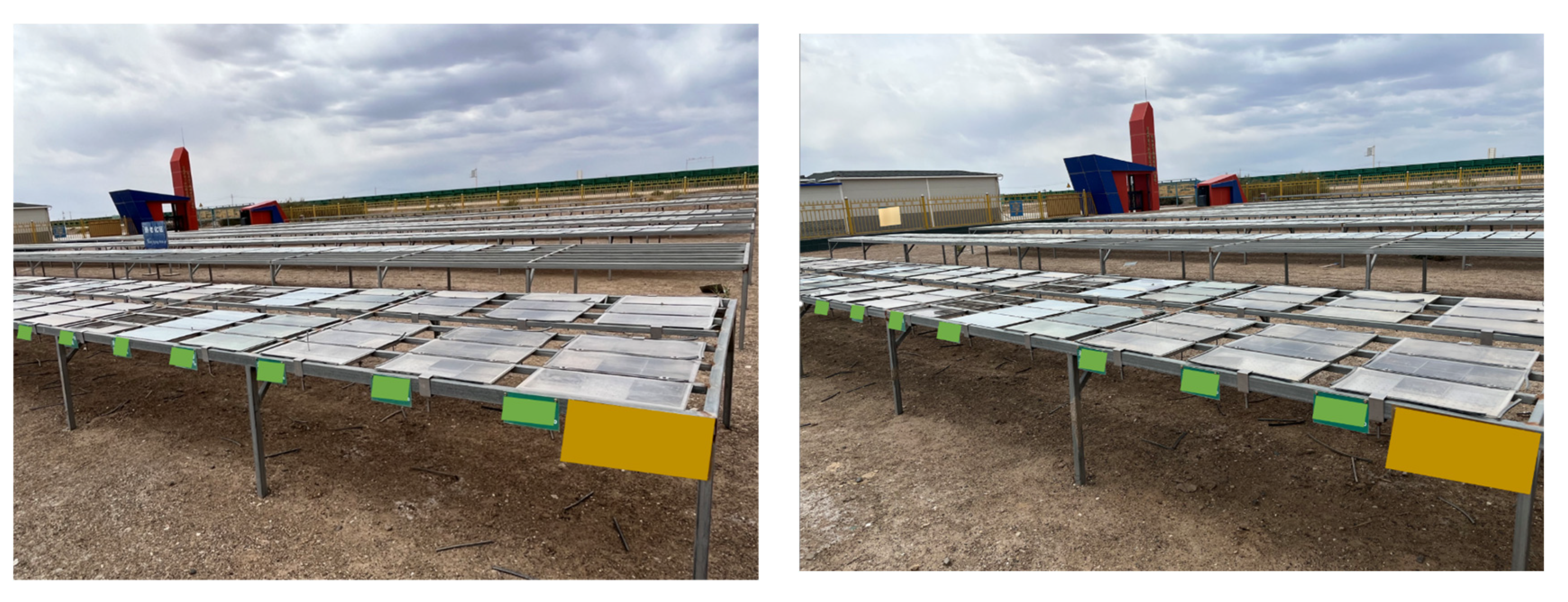

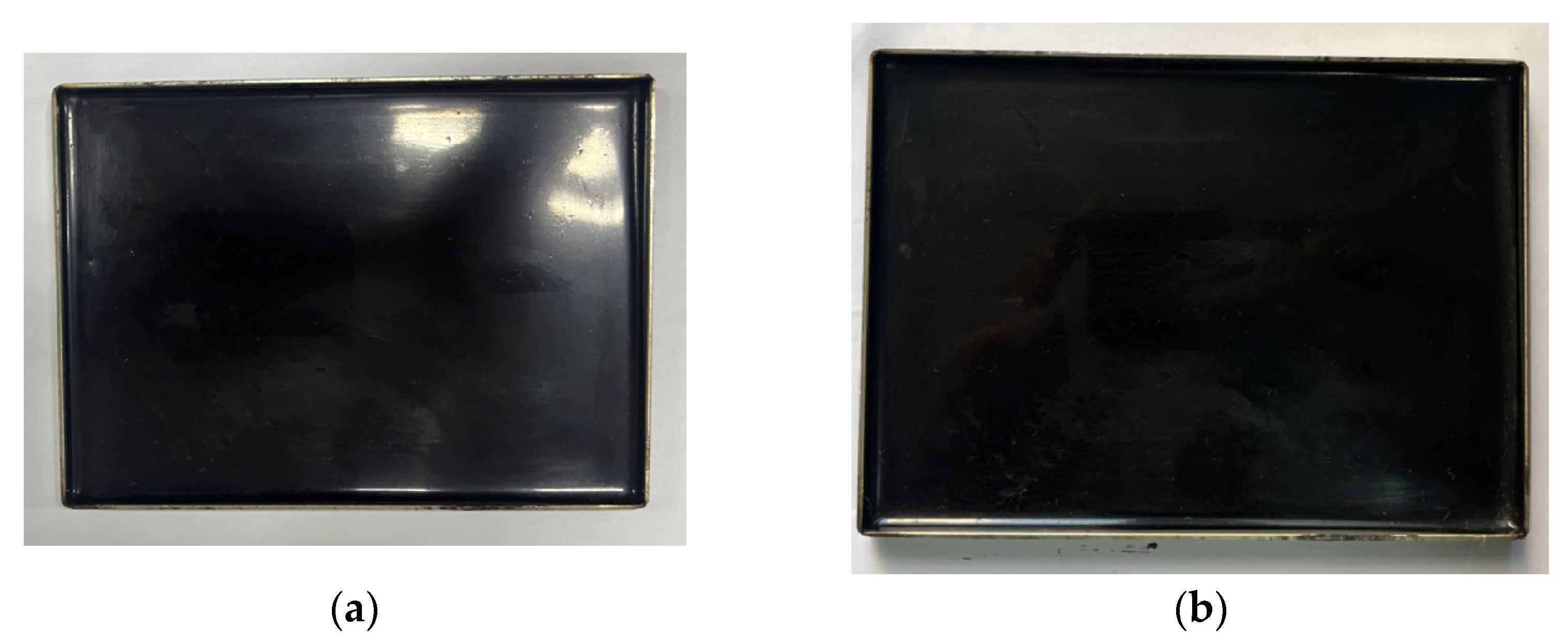


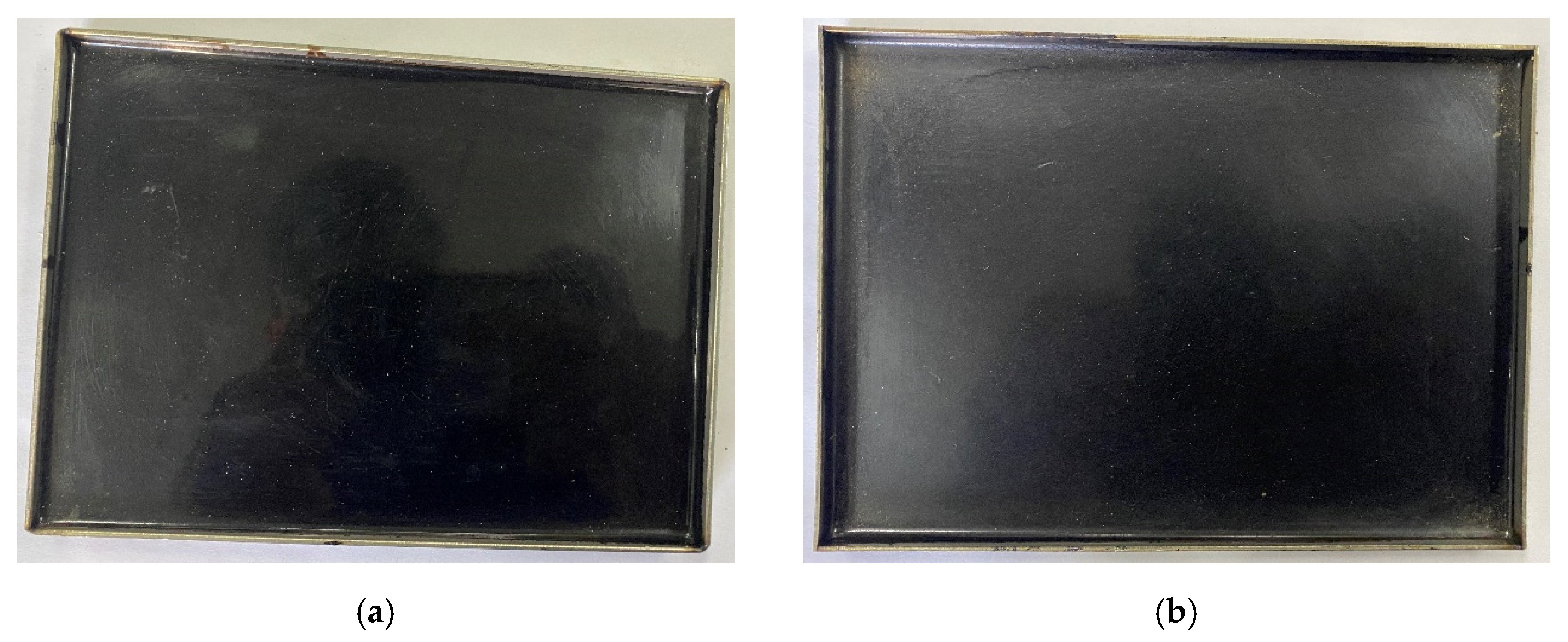
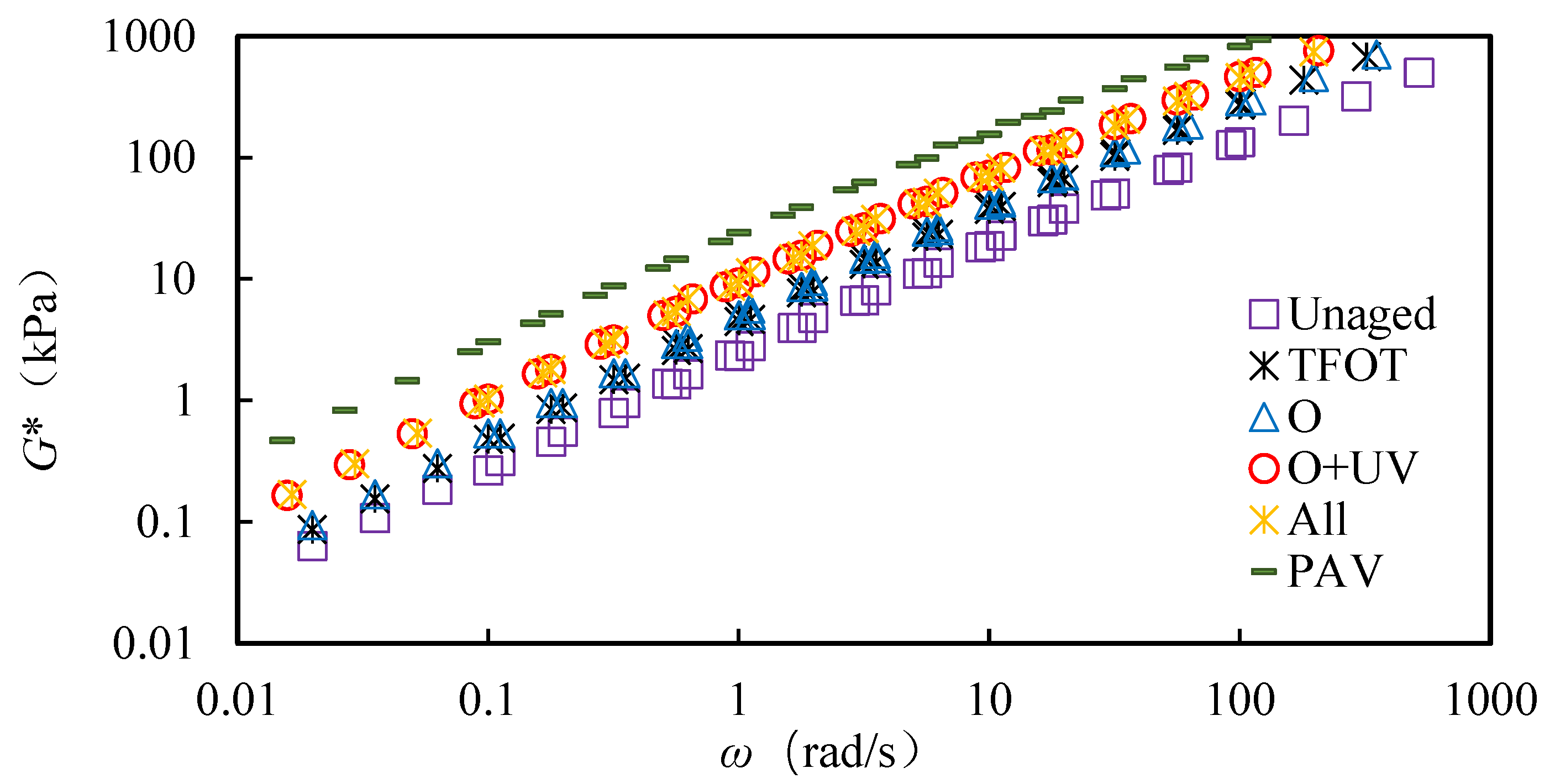

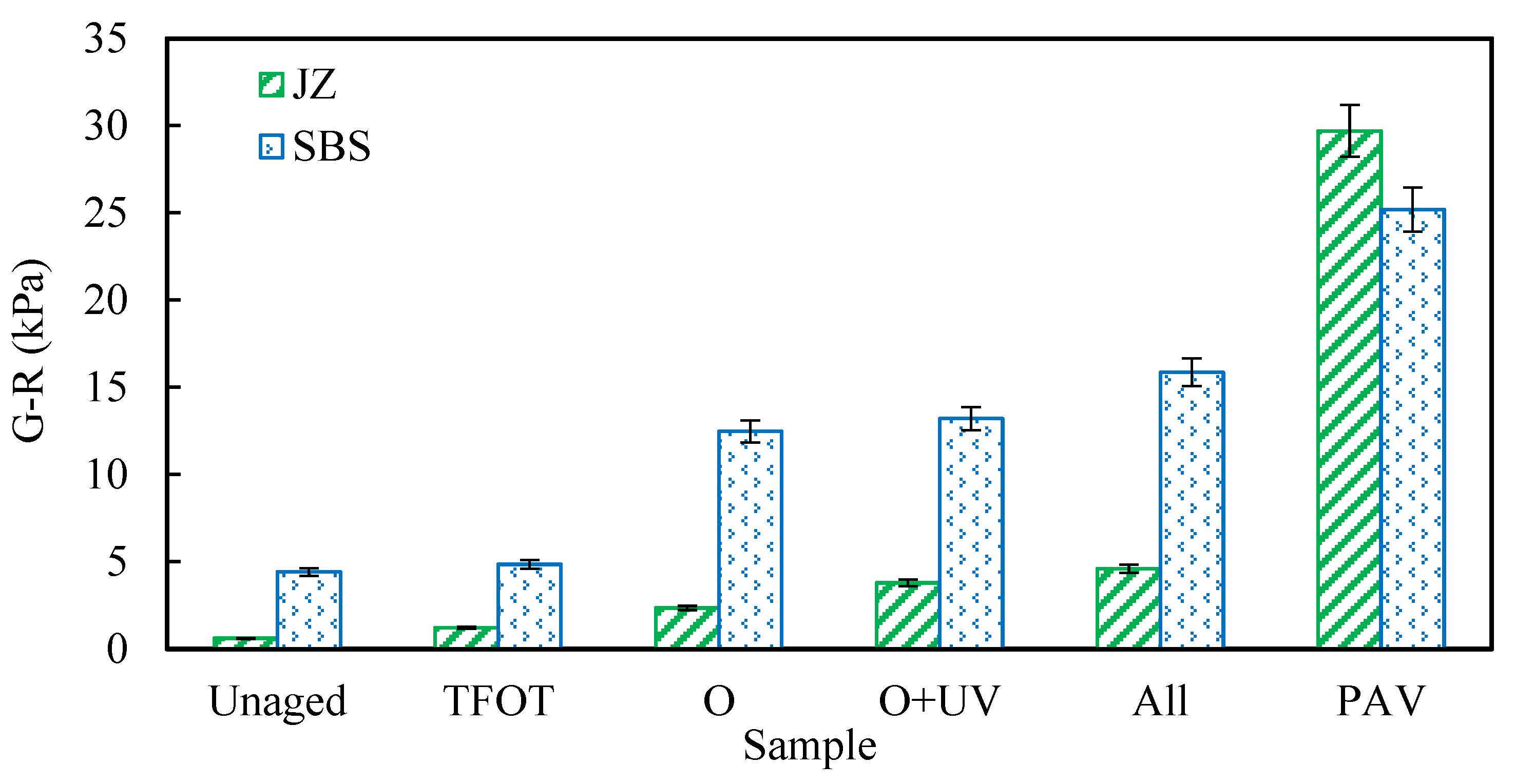


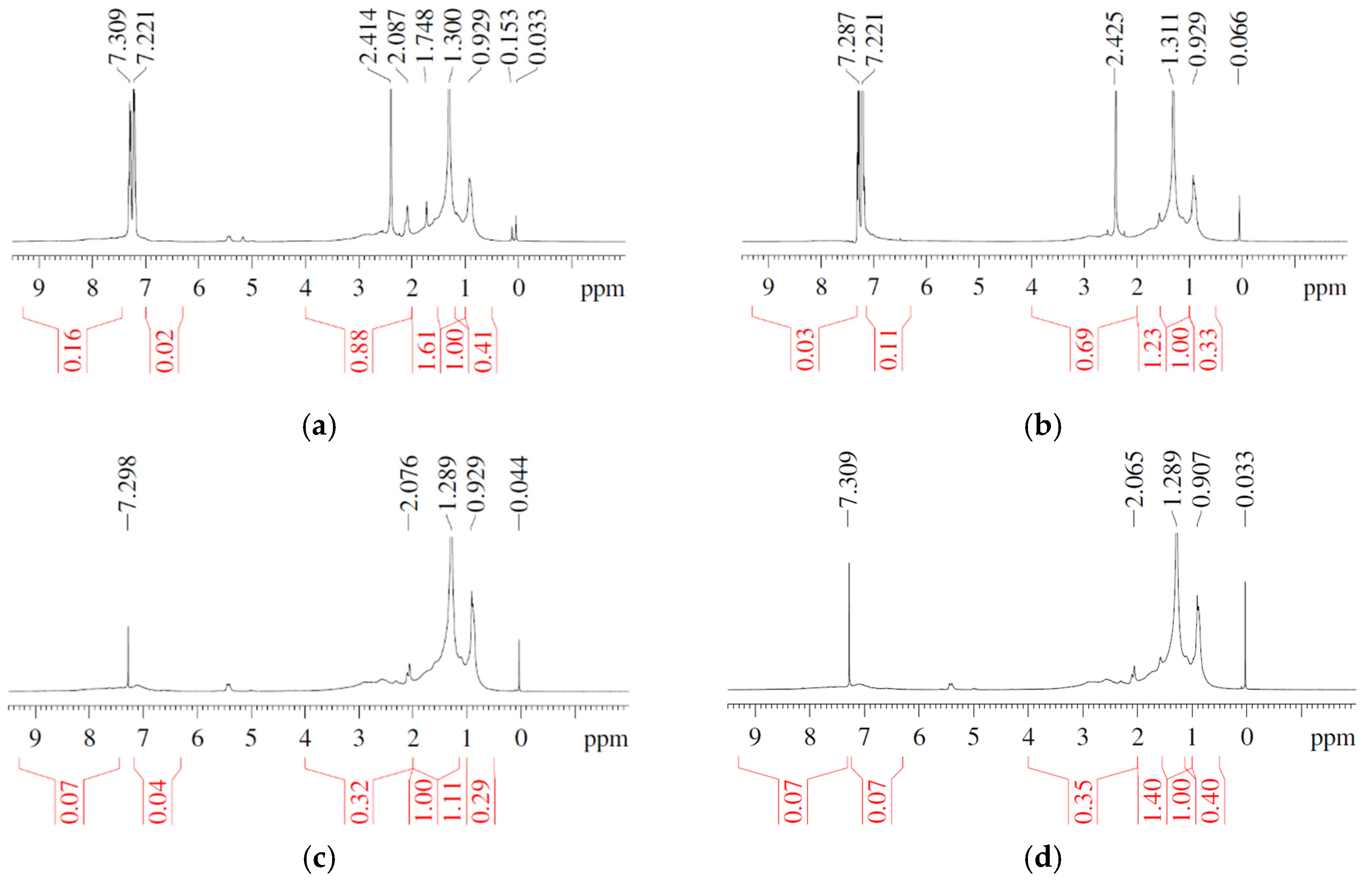



| Indicators | Results | Standard | ||
|---|---|---|---|---|
| Penetration (25 °C, 100 g, 5 s)/0.1 mm | 81.5 | 80~100 | JTG F40 | |
| Wax content/% | 0.6 | ≤2.2 | ||
| Ductility (5 cm/min, 10 °C)/cm | 100 | ≥30 | ||
| Softening point/°C | 45 | ≥44 | ||
| Flashpoint/°C | 305 | ≥245 | ||
| Solubility (trichloroethylene)/% | 99.8 | ≥99.5 | ||
| Aging test (163 °C, 5 h) | Mass change/% | −0.13 | ≤±0.8 | |
| Residual penetration ratio/% | 64 | ≥57 | ||
| Residual ductility Ratio/% | 11 | ≥8 | ||
| Indicators | Results | Standard | ||
|---|---|---|---|---|
| Penetration (25 °C, 100 g, 5 s)/0.1 mm | 66 | 60~80 | JTG F40 | |
| Ductility (5 cm/min, 5 °C)/cm | 42 | ≥30 | ||
| Softening point/°C | 87.5 | ≥55 | ||
| Flashpoint/°C | 280 | ≥230 | ||
| Solubility (trichloroethylene)/% | 99.5 | ≥99 | ||
| Elastic recovery (25 °C) | 80 | ≥65 | ||
| Storage stability (Softening point difference, 48 h) | 1.0 | ≤±2.5 | ||
| Aging test (163 °C, 5 h) | Mass change/% | −0.4 | ≤±1.0 | |
| Residual penetration ratio/% | 75 | ≥60 | ||
| Residual ductility Ratio/% | 30 | ≥20 | ||
| Hydrogen | Attribution | Chemical Shift, ppm |
|---|---|---|
| HA | Hydrogen is directly linked to aromatic carbon | 6.3~9.3 |
| Hα | Hydrogen is linked to the α-carbon of the aromatic ring | 2.0~4.0 |
| Hβ | Hydrogen on the β-carbon of the aromatic ring and the CH2 and CH groups farther from β-carbon | 1.0~2.0 |
| Hγ | Hydrogen in the γ-position of the aromatic ring and the CH3 group far from γ | 0.5~1.0 |
| HA | Hα | Hβ | Hγ | |
|---|---|---|---|---|
| Unaged | 0.058 | 0.204 | 0.583 | 0.154 |
| TFOT | 0.060 | 0.197 | 0.586 | 0.157 |
| O-aging | 0.051 | 0.148 | 0.603 | 0.198 |
| O+UV-aging | 0.067 | 0.149 | 0.608 | 0.176 |
| All-aging | 0.066 | 0.153 | 0.612 | 0.169 |
| PAV | 0.067 | 0.201 | 0.202 | 0.155 |
| HA | Hα | Hβ | Hγ | |
|---|---|---|---|---|
| Unaged | 0.058 | 0.286 | 0.583 | 0.133 |
| TFOT | 0.059 | 0.289 | 0.515 | 0.138 |
| O-aging | 0.060 | 0.175 | 0.607 | 0.158 |
| O+UV-aging | 0.061 | 0.153 | 0.611 | 0.175 |
| All-aging | 0.066 | 0.159 | 0.615 | 0.159 |
| PAV | 0.074 | 0.279 | 0.499 | 0.148 |
| Binder | Modules | AC=O | AS=O | AC-H | IC=O | IS=O |
|---|---|---|---|---|---|---|
| Virgin asphalt binder | Unaged | 0.289 | 0.754 | 18.244 | 0.0158 | 0.0413 |
| TFOT | 0.254 | 0.751 | 17.616 | 0.0144 | 0.0426 | |
| O | 0.287 | 1.853 | 18.096 | 0.0159 | 0.1024 | |
| O+UV | 0.296 | 2.490 | 16.760 | 0.0177 | 0.1486 | |
| All | 0.360 | 2.590 | 17.792 | 0.0202 | 0.1456 | |
| PAV | 0.499 | 2.154 | 16.086 | 0.0310 | 0.1339 | |
| SBS-modified asphalt binder | Unaged | 0.540 | 0.138 | 17.933 | 0.0301 | 0.0077 |
| TFOT | 0.061 | 1.140 | 18.201 | 0.0034 | 0.0626 | |
| O | 0.227 | 2.244 | 17.666 | 0.0128 | 0.1270 | |
| O+UV | 0.241 | 1.936 | 17.709 | 0.0136 | 0.1093 | |
| All | 0.2000 | 2.226 | 17.620 | 0.0114 | 0.1263 | |
| PAV | 0.612 | 3.455 | 17.644 | 0.0347 | 0.1958 |
Disclaimer/Publisher’s Note: The statements, opinions and data contained in all publications are solely those of the individual author(s) and contributor(s) and not of MDPI and/or the editor(s). MDPI and/or the editor(s) disclaim responsibility for any injury to people or property resulting from any ideas, methods, instructions or products referred to in the content. |
© 2023 by the authors. Licensee MDPI, Basel, Switzerland. This article is an open access article distributed under the terms and conditions of the Creative Commons Attribution (CC BY) license (https://creativecommons.org/licenses/by/4.0/).
Share and Cite
Song, S.; Wang, L.; Fu, C.; Guo, M.; Jiang, X.; Liang, M.; Yan, L. Study on the Aging Behavior of Asphalt Binder Exposed to Different Environmental Factors. Appl. Sci. 2023, 13, 12651. https://doi.org/10.3390/app132312651
Song S, Wang L, Fu C, Guo M, Jiang X, Liang M, Yan L. Study on the Aging Behavior of Asphalt Binder Exposed to Different Environmental Factors. Applied Sciences. 2023; 13(23):12651. https://doi.org/10.3390/app132312651
Chicago/Turabian StyleSong, Shanglin, Linbing Wang, Chunping Fu, Meng Guo, Xiaoqiang Jiang, Meichen Liang, and Luchun Yan. 2023. "Study on the Aging Behavior of Asphalt Binder Exposed to Different Environmental Factors" Applied Sciences 13, no. 23: 12651. https://doi.org/10.3390/app132312651
APA StyleSong, S., Wang, L., Fu, C., Guo, M., Jiang, X., Liang, M., & Yan, L. (2023). Study on the Aging Behavior of Asphalt Binder Exposed to Different Environmental Factors. Applied Sciences, 13(23), 12651. https://doi.org/10.3390/app132312651








